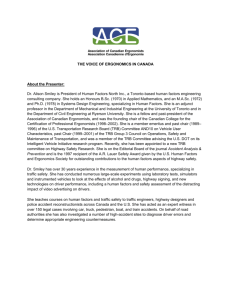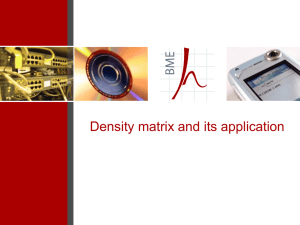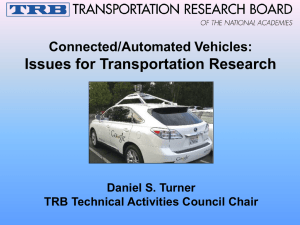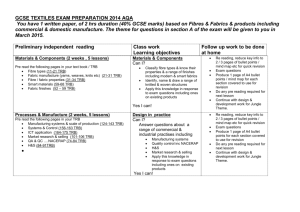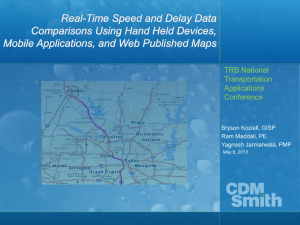Presentation - 15th TRB National Transportation Planning
advertisement
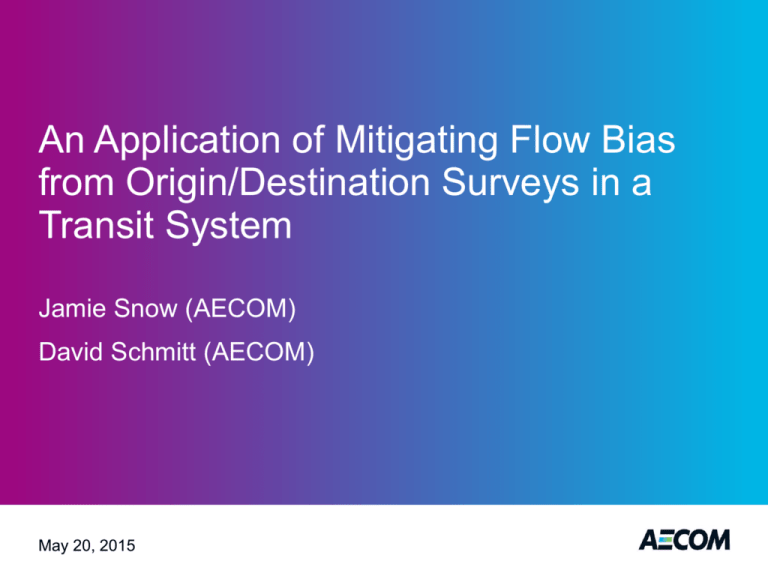
An Application of Mitigating Flow Bias from Origin/Destination Surveys in a Transit System Jamie Snow (AECOM) David Schmitt (AECOM) May 20, 2015 Addressing Flow Bias in Transit Surveys • Accurate information on flows is critical in transportation planning • Observation: Expansion methods using only the origin/ destination survey typically under-represent short trips and misrepresent flows – Difficult to know where the biases occur • Can flows be made more accurate using auxiliary data and iterative proportional fitting (IPF) techniques? 2015 TRB Planning Applications Conference May 20, 2015 Page 2 Advanced Expansion Process (AEP) Methodology Define route segmentation Develop segmentto-segment on-tooff flows using survey and ancillary data Develop origin/destination segment-tosegment flows using survey Apply expansion factors to main survey records Create synthetic origin/destination records where necessary Divide on-to-off flows by origin/destination flows 2015 TRB Planning Applications Conference May 20, 2015 Page 3 Define Route Segmentation • Segment the transit routes using – Natural boundaries – Major cross streets – Large differences in travel patterns • Local routes represented by 4-6 segments • Express and crosstown routes represented by 2-3 segments 2015 TRB Planning Applications Conference May 20, 2015 Page 4 Develop On-to-off Flows • Automatic Passenger Counter (APC) data – Averaged over 5 months – Used to generate the column and row marginals for IPF • On-to-off counts – Collected at 20% or 100% sampling rate, depending on route – Used to generate the “seed” matrices for the IPF process – Developed synthetic records where APC and/or OD > 0 but On-to-off = 0 • Use IPF to expand on-to-off counts – On-to-off counts as “seed” matrices – APC counts for row/column marginals – Result: segment-to-segment flows 2015 TRB Planning Applications Conference May 20, 2015 Page 5 Using IPF to Develop Segment to Segment Flows Generated from the on-to-off data by route, time period, direction, and segment Generated from the APC data by route, time period, direction, and segment Indicates the need for a Synthetic Record 2015 TRB Planning Applications Conference May 20, 2015 Page 6 Develop Origin/Destination (OD) Flows • Initial expansion factors developed by dividing segment-tosegment flows expanded to APC values by segment-tosegment count of OD survey records • Synthetic records developed in cells where On-to-off flows and/or APC > 0 but OD = 0 2015 TRB Planning Applications Conference May 20, 2015 Page 7 Origin/Destination Expansion Example Segment-tosegment flows expanded to APC values Segment-tosegment count of OD survey records * Segment-tosegment expansion factors *Synthetic origin/destination survey record 2015 TRB Planning Applications Conference May 20, 2015 Page 8 Performed by direction and time period for each route * Synthetic OD survey records developed where the observed flow > 0 but count of main survey records = 0 Is AEP Better Than Traditional RTD Expansion? • Traditional expansion: route, time period, and direction using OD survey only (RTD) • Objective: compare AEP results to traditional expansion results using APC data as the “ground truth” • Metrics • Mean Absolute Percent Error (MAPE) • Root Mean Square Error (RMSE) • Three COTA routes • Local Route 1 (large – 8,800 daily boardings) • Crosstown Route 89 (medium – 1,000 daily boardings) • Express Route 61 (small – 150 daily boardings) 2015 TRB Planning Applications Conference May 20, 2015 Page 9 Comparison Results – Local Route 1 Average Daily Ridership = 8,824 Expanding the data using RTD produces mean absolute percentage errors that are 3-5 times higher than expanding the data with the AEP Similarly root mean square errors are 2-4 times higher expanding the data using RTD 7 segments 2015 TRB Planning Applications Conference May 20, 2015 Page 10 Comparison Results – Route 89 Average Daily Ridership = 999 Similar to Route 1, AEP expansion has less MAPE than RTD. Less segmentation of the route begins to close the gap between expansion methods RMSEs are closer but AEP methodology still drastically outperforms RTD expansion 3 segments 2015 TRB Planning Applications Conference May 20, 2015 Page 11 Comparison Results – Route 61 Average Daily Ridership = 139 2 segments Again, AEP outperforms RTD expansion when comparing MAPE When the minimal number of segments are utilized, RMSE for both methodologies are very similar 2015 TRB Planning Applications Conference May 20, 2015 Page 12 Results Continued AEP methodology addresses flow movements better using number of segments traveled; minimizes short trip bias 2015 TRB Planning Applications Conference May 20, 2015 Page 13 Results Continued Expansion Factor (EF) Criteria Criteria EF=0 0-0.4 0.4-1.0 1.0-2.0 Total EF>2.0 % of Total Total # of Records 288 355 1,759 10,965 149 13,516 100% % of the Total 2% 3% 13% 81% 1% 100% 0 190 256 582 10 1,038 8% 200 0 0 0 0 200 1% 88 0 0 0 0 88 1% OD sampling rate to On2Off sampling rate by a ratio > 1.5 0 86 673 589 0 1,348 10% OD sampling rate to On2Off sampling rate by a ratio <0.3333 0 0 0 0 139 139 1% On2Off expansion factor 0 - 0.5 0 58 155 442 0 655 5% Result of RTD expansion (no On2Off records collected) 0 21 48 117 0 186 1% Reasonable expansion factors in both surveys 0 0 627 9,235 0 9,862 73% How many are/include Synthetic Records Missing O, B, A, and/or D? Erroneous information? Large number of OD survey records with an expansion factor less than 1.0 (+2,400 or 18%) 2015 TRB Planning Applications Conference May 20, 2015 Page 14 The causes were explicable based on the data Conclusions • Using IPF with on-to-off flow data and APCs produces more accurate boarding and alighting results than RTD in these routes • Also improved representation of short trips • Missing flow movements incorporated into the expanded dataset which removed biases from over- and underweighting of various flow movements 2015 TRB Planning Applications Conference May 20, 2015 Page 15 Acknowledgements Rebekah Anderson, Ohio Department of Transportation Dr. Mark McCord, The Ohio State University Dr. Rabi Mishalani, The Ohio State University Mike, McCann, The Central Ohio Transportation Authority 2015 TRB Planning Applications Conference May 20, 2015 Page 16 Thank you Jamie.Snow@aecom.com David.Schmitt@aecom.com May 20, 2015
